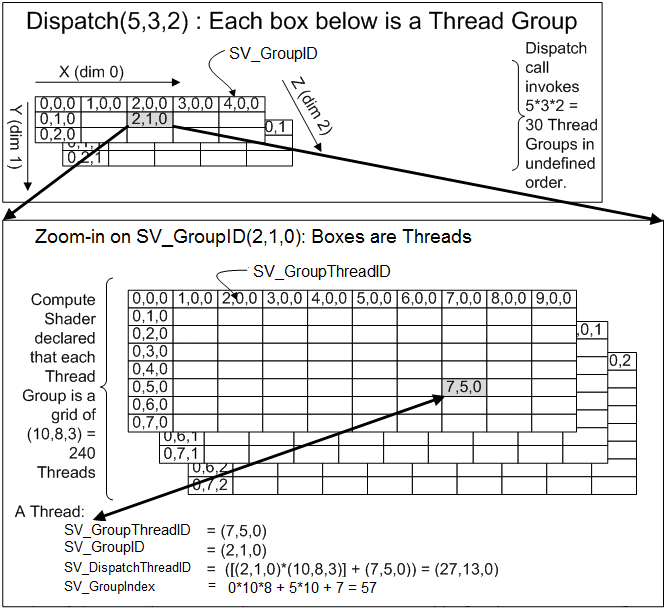ITESO GPU programming Hwks and reads
- GPU Architecture
- Ray casting
Vertical operations and horizontal operations:
Application:
Point product between two vectors.
With the vertical product ans horizontal sum.
V0=[1,2,3,4]
V1=[4,3,2,1]
Dot(V0,V1) = 20
C<-V0*V1= [4,6,6,4] <- vertical operation
C := C h+ C // apply horizontal sumation
[10,10,10,10]V0=[1,2,3,4]
V1=[5,6,7,8]
Dot(V0,V1) = 70
C<-V0*V1= [5,12,21,32] <- vertical operation
C := C h+ C // apply horizontal sumation
[5,12,21,32]
[5+12,21+32,5+12,32+21]
[17, 53, 17, 53]
[70,70,70,70]Visual studio
debug flag: _DEBUG
Cambia cuando se cambia el modo de release a debug
- Group is the minimum unit of computation for directx.
- Every unit is a cube with 3 dimensions
- Grupo: Equipo de hilos que comparten variables globales.
- The cpu starts cubes in the GPU.
https://msdn.microsoft.com/en-us/library/windows/desktop/ff476405(v=vs.85).aspx
int x; // this variable is only visible for this Group
// define the number and structure of the Group
[numthreads(1,1,1)]
void main()
{
}
DirectX transfers data from system memory into video memory when the creation methods
are called. An example of a creation method is ID3D11Device::CreateBuffer. This method requires a pointer to the memory location of where the data is, so it can be copied from
system RAM to video RAM. However, if the pointer that is passed into, is a null pointer
then just sets the amount of space, so you can copy the data later.
Example:
// Fill in a buffer descrition
D3D11_BUFFER_DESC bufferDesc;
bufferDesc.Usage = D3D11_USAGE_DYNAMIC;
bufferDesc.ByteWidth = sizeof(Vertex_dynamic) * m_iHowManyVertices;
bufferDesc.BindFlags = D3D11_BIND_VERTEX_BUFFER;
bufferDesc.CPUAccessFlags = D3D11_CPU_ACCESS_WRITE;
bufferDesc.MiscFlags = 0;
bufferDesc.StructureByteStride = NULL;
// Fill in the subresource data.
D3D11_SUBRESOURCE_DATA InitData;
InitData.pSysMem = &_vData[0];
InitData.SysMemPitch = NULL;
InitData.SysMemSlicePitch = NULL;
// Create the vertex buffer.
/*Data is being copyed right now*/
m_pDxDevice->CreateBuffer(&bufferDesc, &InitData, &m_pDxVertexBuffer_PiecePos);| CPU | GPU |
|---|---|
| Low latency memory | high bandwidth memory |
| random accesses | sequential accesses |
| 0.1 Tflop compute | 1Tflop computing |
| 1GFlop/watt | 10GFlog/watt |
The CPU is designed to handle random access operations.
| method | descrition |
|---|---|
| GetDimemensions | Gets the resource dimensions |
| Load | Reads the buffer data |
| Operator[] | Returns a read only resource variable |
A read write buffer that can take a T type that is a structure.
context & factory
StructuredBuffer Input;
RWStructuredBuffer Output; /* Read write StructuredBuffer */
int x;
[numthreads(10,8,3)]
void main(uint3 id:SV_DispatchThreadID)
{
}Constant buffer: Es una regrion de memoria interna en el GPU para parametrizar el funcionamiento de los compute shaders, antes de que estos se inicien.
Una vez iniciada la ejecucion de un compute shader, esas varaibles son consideradas de solo lectura
La ventaja de los constant buffers es que el cpu puede actualizar el valor de estas variables en cualquier momento y de manera eficiente.
- Crear un buffer con las siguientes caracteristicas * D3D11_BIND_CONSTANTBUFFER, * D3D11_CPU_ACCESS_WRITE * El tamaño de un constatn buffer debe ser multiplo de 16 bytes.
- No se requiere vista para un constant buffer.
- El formato del contendio queda definido por el programador
Paso de matrices, paso de parametros simples, valores iniciales, iteraciones maximas, etc. El dispatcher solo da como parametros el thread id
- Define a structute that defines the vertex shader constant data.
- Allocate memory for the structure defined in the previous step. Fill this buffer with vertex shader constatn data. (you can user malloc or new or you can allocate memory from the stack.)
- Create a buffer descriptor by filling a
D3D11_BUFFER_DESCstructure. Pass theD3D11_BIND_CONSTANTBUFFERflag to theBindFlagsmemeber and pass the size of the constant buffer description structure in bytes to theByteWidthmemeber.
In order to get a visual studio project to compile a hlsl shader add the next external dependencies in the menu>project>settings
- dxguid.lib
- dxgi.lib
- d3d11.lib
- d3dcompiler.lib
Los timers se deben de poner en initialize, y despues de inicializar DirectCompute.
switch (message) {
case WM_TIMER:
switch (wParam) {
case 1:
InvalidateRect(hWnd)
}
}
/* En init instacen antes de mostrar las particulas pero despeus de crearlas */
SetTimer(hWnd, 1, 10, 10);
// Ya en el codigo aactual
Showwindow(hWnd, nCmdShow);
UpdateWindow(hWnd);
// En case wm_paint
pDev->CreateRenderTargetView(pBackBuffer, NULL, &pRTV);
float Color[4] = {0.2,0.3,0.6,0};
pRTV->Release();
/* No ahy shader que limpie el render target */Intrinsic types, son parte intrinsica de del lenguaje.
What is a render target? https://msdn.microsoft.com/en-us/library/bb976073(v=xnagamestudio.31).aspx
https://web.cse.ohio-state.edu/~wang.3602/courses/cse5542-2013-spring/
https://msdn.microsoft.com/en-us/library/windows/desktop/bb509646(v=vs.85).aspx
https://msdn.microsoft.com/en-us/library/windows/desktop/dn508414(v=vs.85).aspx
Tutorial: https://www.codinglabs.net/tutorial_compute_shaders_filters.aspx
HLSL types: https://msdn.microsoft.com/en-us/library/windows/desktop/bb509634(v=vs.85).aspx
https://software.intel.com/sites/default/files/m/d/4/1/d/8/DirectCompute_on_DirectX_11.pdf
https://code.msdn.microsoft.com/windowsdesktop/DirectCompute-Basic-Win32-7d5a7408#content
Dispatch method: https://msdn.microsoft.com/en-us/library/windows/desktop/ff476405(v=vs.85).aspx
https://code.msdn.microsoft.com/DirectCompute-Basic-Win32-7d5a7408
https://gpgpu.org/index.php?s=SIGGRAPH
registers:
https://msdn.microsoft.com/en-us/library/hh447206(v=VS.85).aspx

